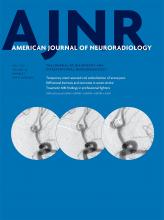Research ArticleAdult Brain
Discrimination between Glioma Grades II and III Using Dynamic Susceptibility Perfusion MRI: A Meta-Analysis
Anna F. Delgado and Alberto F. Delgado
American Journal of Neuroradiology July 2017, 38 (7) 1348-1355; DOI: https://doi.org/10.3174/ajnr.A5218
Anna F. Delgado
aFrom the Department of Clinical Neuroscience (Anna F.D.), Karolinska Institute, Stockholm, Sweden
Alberto F. Delgado
bDepartment of Surgical Sciences (Alberto F.D.), Uppsala University, Uppsala, Sweden.

References
- 1.↵
- Boxerman JL,
- Schmainda KM,
- Weisskoff RM
- 2.↵
- 3.↵
- Law M,
- Young R,
- Babb J, et al
- 4.↵
- Hilario A,
- Ramos A,
- Perez-Nuñez A, et al
- 5.↵
- 6.↵
- 7.↵
- Law M,
- Yang S,
- Wang H, et al
- 8.↵
- Park MJ,
- Kim HS,
- Jahng GH, et al
- 9.↵
- Van Cauter S,
- De Keyzer F,
- Sima DM, et al
- 10.↵
- 11.↵
- Emblem KE,
- Scheie D,
- Due-Tonnessen P, et al
- 12.↵
- 13.↵
- Law M,
- Young R,
- Babb J, et al
- 14.↵
- 15.↵
- Nasseri M,
- Gahramanov S,
- Netto JP, et al
- 16.↵
- Hu LS,
- Kelm Z,
- Korfiatis P, et al
- 17.↵
- 18.↵
- 19.↵
- Crocetti E,
- Trama A,
- Stiller C, et al
- 20.↵
- Kelly PJ,
- Daumas-Duport C,
- Kispert DB, et al
- 21.↵
- Catalaa I,
- Henry R,
- Dillon WP, et al
- 22.↵
- 23.↵
- Nguyen TB,
- Cron GO,
- Perdrizet K, et al
- 24.↵
- 25.↵
- 26.↵
- Toyooka M,
- Kimura H,
- Uematsu H, et al
- 27.↵
- 28.↵
- Moher D,
- Liberati A,
- Tetzlaff J, et al
- 29.↵
- 30.↵
- Whiting PF,
- Rutjes AW,
- Westwood ME, et al
- 31.↵
- Higgins JP,
- Green S
- 32.↵
- 33.↵
- Light RJ,
- Pillemer DB
- 34.↵
- Doebler P,
- Holling H
- 35.↵R Development Core Team. R: A Language and Environment for Statistical Computing. Vienna: R Foundation for Statistical Computing; 2010
- 36.↵Review Manager (RevMan). 5.3 ed. Copenhagen: The Nordic Cochrane Centre: The Cochrane Collaboration; 2014 http://www.medsci.cn/webeditor/uploadfile/201408/20140815214316360.pdf. Accessed September 6, 2016.
- 37.↵
- Falk A,
- Fahlström M,
- Rostrup E, et al
- 38.↵
- Cairncross JG,
- Wang M,
- Jenkins RB, et al
- 39.↵
- van den Bent MJ,
- Brandes AA,
- Taphoorn MJ, et al
- 40.↵
- 41.↵
- 42.↵
- 43.↵
- Yablonskiy DA,
- Haacke EM
In this issue
American Journal of Neuroradiology
Vol. 38, Issue 7
1 Jul 2017
Advertisement
Anna F. Delgado, Alberto F. Delgado
Discrimination between Glioma Grades II and III Using Dynamic Susceptibility Perfusion MRI: A Meta-Analysis
American Journal of Neuroradiology Jul 2017, 38 (7) 1348-1355; DOI: 10.3174/ajnr.A5218
0 Responses
Jump to section
Related Articles
Cited By...
This article has not yet been cited by articles in journals that are participating in Crossref Cited-by Linking.
More in this TOC Section
Similar Articles
Advertisement











